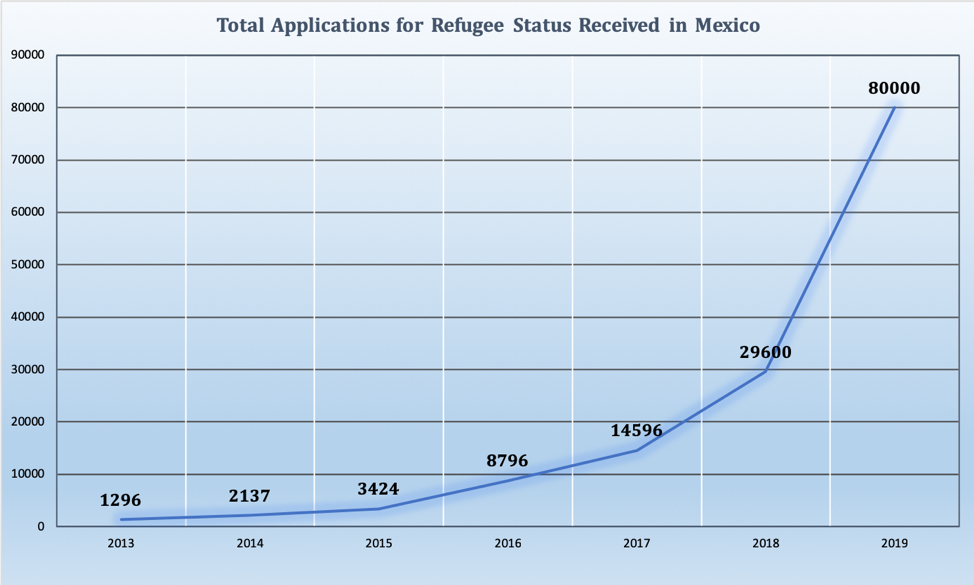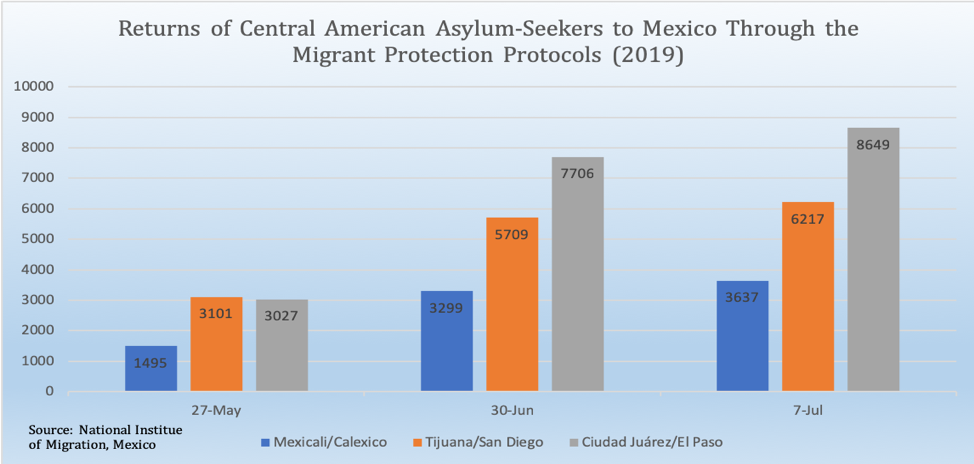Following the Trump administration’s announcement (and subsequent revocation) of tariffs on Mexican products, which were designed to push Mexico towards a stricter regulation of its southern border, the two countries reached an agreement about what Mexico’s role will be in managing regional migration.
In a joint declaration, the two countries agreed that: Mexico would take “unprecedented” steps to curb irregular migration, that the United States would expand its Migrant Protection Protocols—also known as the Remain in Mexico Policy—that the two countries would take further actions if the agreed-upon measures “don’t have the expected results,” and that the U.S. and Mexico would uphold the terms of their December 18, 2019 commitment to launch the Comprehensive Development Plan, in concert with the governments of El Salvador, Guatemala, and Honduras.
Since then, Mexico has implemented various changes to its migration policy. Outlined below are some recent events that will affect migration in the region, as well as what the implications might be for U.S. immigration policy.
The Numbers
On World Refugee Day, Alejandro Encinas Rodriguez, Mexico’s Sub-Secretary for Human Rights, Population and Migration, announced that Mexico may receive 80,000 applications for refugee status in 2019 —up from previous predictions of 60,000. This would be a 6,000 percent increase from the total number of applications received in 2013. So far, during the first six months of 2019, over 30,000 individuals have applied for refugee status in Mexico.

In addition to applications for refugee status Mexico has, to date, received more than 15,000 individuals through the Remain in Mexico policy, who have been sent to border towns that lack the capacity to properly house them. As stipulated in the joint declaration, these numbers have recently increased; in fact, of the 15,000 sent to Mexico since January, the majority have been sent within the past month. Added to all the above are the 68,800 Mexicans that have been deported from the United States between January to April of 2019, many of whom were sent back to the same border cities that have recently received large numbers of asylum seekers.

Safe Third Country Talks
Though not mentioned explicitly in the joint declaration, the United States has also been pressuring Mexico to declare itself a safe third country, which would force Central American migrants to apply for asylum status in Mexico and make them ineligible to apply in the U.S. While Mexico’s Foreign Secretary has reiterated that Mexico will not accept a safe third country agreement, Guatemala and the United States are nearing completion of a safe third country agreement that would require Salvadorans and Hondurans to apply for asylum in Guatemala.
This would prove to be problematic because neither Mexico nor Guatemala are fit to be considered safe third countries; Mexico’s migration system currently lacks the capacity to adjudicate thousands more claims and Guatemalans comprise the second highest number of U.S. asylum applications, mostly due to widespread gang violence.
INM Overhaul
Recent changes within Mexico’s National Institute of Migration (INM by its Spanish abbreviation) may also impact the terms of the joint declaration. Tonatiuh Guillén López—an academic and the former president of the Colegio de la Frontera Norte, a Mexican think tank well-known for its immigration studies—resigned from the INM in mid-June. He was replaced by Francisco Garduno Yañez, the former director of Mexico’s prison system, who has experience in human rights, but little experience in migration. Garduno said he will focus on reducing corruption within the INM and protecting the human rights of migrants. But, he’s also said he plans to deport over 70,000 migrants a month; for reference Mexico deported only 60,000 migrants between October-April of 2018.
In its efforts to crack down on corruption, the INM has fired 500 officials since the beginning of the year, but since April, it has only hired 239 new officials. This puts it far behind its target of 3,000 agents; the INM currently has around 1,400.
COMAR, Mexico’s refugee agency, which operates separately from the INM, is also understaffed. As of June, COMAR has about 50 officials countrywide, who would be responsible for reviewing the estimated 80,000 refugee applications for 2019—as well as the roughly 40,000 applications that have been backlogged from previous years. To date, the United States has not pledged any money in support for COMAR, but the UNHCR recently pledged an additional $1 million, nearly doubling COMAR’s budget.
Deployment of Troops to the Border
As stipulated in the joint declaration, Mexico has sent 2,000 members of its newly minted National Guard to its southern border with Guatemala, joining the 4,500 troops that had already been deployed. Additionally, Mexico sent 15,000 troops to its northern border, which wasn’t required by the joint declaration. Mexico’s defense minister reiterated last week that the National Guard will be chiefly tasked with turning undocumented migrants over to the INM, and not carrying out deportation operations.
Still, human rights experts have expressed concern, considering that the National Guard—which will eventually replace Mexico’s federal police and will be composed of military police, Navy, Army, federal police and thousands of new recruits—was just created and officers have yet to receive the critical human rights training that they are required to receive. The National Guard has limited jurisdiction when it comes to migration; according to the law’s Article 9, XXXV and XXXVI, it is authorized to inspect migrants’ documents and “protect” INM detention centers. In practice, as reporting has shown in the past week, the National Guard has been detaining migrants and video footage shows them searching for migrants in Mexico’s southern border towns.
Detention Facilities
Already squalid conditions in Mexican detention centers have reportedly gotten worse as Mexico has detained more migrants and received more asylum seekers through the Remain in Mexico program. Detention centers in both the southern and northern border region are overcrowded, and conditions are arguably worse than in U.S. detention facilities. Reporting by the National Network of Civil Human Rights through an observation mission comprised of 24 organizations with academics and journalists, has confirmed that children have been separated from their parents and guardians in various detention facilities throughout the country, health conditions remain notably precarious, and instances of racism and xenophobia have been documented. Without dedicated resources for Mexico’s INM and other migration institutions, it is likely those conditions will worsen.
In an effort to create job opportunities for some migrants and move them out of overcrowded detention facilities, Mexico’s president Andrés Manuel López Obrador announced that he will sign an agreement with a number of factories throughout the country to provide up to 40,000 jobs.
Implications for the U.S.
The deployment of troops to Mexico’s southern and northern borders appears to have temporarily dissuaded some migrants from crossing. But interviews with smugglers show that once new routes are identified, business will continue as usual. Given that the joint declaration gives 45 days for Mexico to increase its border enforcement efforts—at which point a safe third country agreement or other, more severe measures will become more likely—it’s possible that the numbers will decrease enough to satisfy the Trump administration.
In the long-term, the Administration’s policies and the coercion of Mexico towards a stricter border policy will endanger migrants without creating lasting solutions. Though there’s been a long history of kidnappings of migrants in Mexico, last week’s rescue of 24 migrants in Guanajuato—9 of whom were children—is a timely reminder of the potential consequences of increased security measures without a concomitant increase in efforts to protect migrants.
The Remain in Mexico policy will continue to overcrowd detention centers in northern Mexico, encouraging migrants to opt for unauthorized and life-threatening border crossings instead of waiting in precarious conditions. The policy has even been criticized by the labor union that represents asylum officials, who called it “fundamentally contrary to the moral fabric of our Nation.”
Without comprehensive and systemic immigration reform, support for Mexico’s asylum institutions, the termination or scaling back of the Remain in Mexico policy, significant aid to shelters in Mexico and the U.S., and the passing of an aid package to the southern border, the tariff spectacle by the Trump administration falls short of generating the long-term solutions that the region needs. Additionally, the joint declaration between Mexico and the U.S. fails to consider the human rights of migrants, does little to enhance regional security in the long-term, and jeopardizes productive international relations in the region.